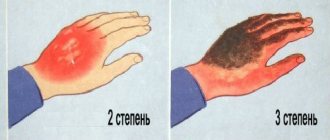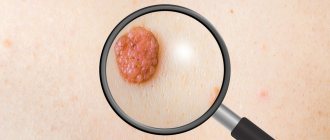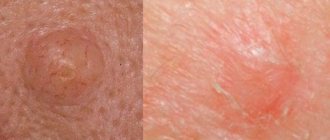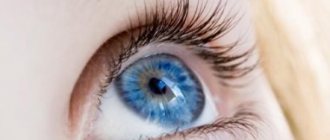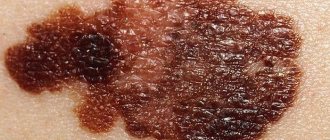Every person has moles, but many do not know that they can be dangerous. Therefore, it is necessary to carefully monitor their appearance and condition.
The birthmark is a benign formation consisting of epithelial cells rich in melanocytes. Nevi appear in a person from birth or form later without causing discomfort. But there are moles that can degenerate into malignant formations, and how can you tell whether it is a mole or melanoma?
What is the difference between a mole and melanoma?
Before answering the question of how to distinguish a mole from melanoma, you should know what types of nevus exist.
Types of moles
- Birthmarks;
- Vascular;
- White.
Nevi are classified according to the following indicators:
- Size;
- Color;
- Depth of origin;
- The degree of danger of degeneration into cancer.
Birthmarks are often inherited, as are the shape of the nose and eye color. The cause of nevus or birthmarks is a large accumulation of abnormal cells containing melanin pigment in one place of the skin. It is he who is responsible for the color of the skin and moles, among which you can find different shades of brown. The degree of saturation of this color is directly related to the genotype.
Nevi with a warm, blue tint are less common than brown moles. This color is explained by the content of pink and white melanocytes in the epidermal cells.
Brown spots in the form of plaques should not be confused with a nevus; these are seborrheic dermatomas, hanging moles are acrochordomas, and “red” moles are hemangiomas.
Moles have different sizes:
- Small – from 1 mm to 1.5 cm;
- Medium - reach 10 cm;
- Large – more than 10 cm;
- Giant ones can cover most of the face or body.
Depending on the location of the mole, there are:
- Borderline - located between the skin and epidermis. Always smooth and flat, but under the influence of hormones or sunlight they can enlarge and become slightly convex with jagged edges.
- Epidermal. They are located in the upper layer of the epidermis. The shape is flat or slightly convex above the dermis.
- Intradermal - formed deep in the skin. Always convex, has a smooth or rough surface. Hairs can grow from it.
According to the degree of risk of oncology, nevi are divided into two types:
- Dangerous - Ota mole, blue nevus, borderline mole, pigmented congenital huge nevus, atypical mole. These formations often degenerate into melanoma and must be removed immediately after diagnosis.
- Non-hazardous. They rarely become cancerous. This can only happen if there was mechanical damage in the form of irritation from clothing or the nevus was damaged during shaving.
Important! The cause of the formation of birthmarks is considered to be a hereditary factor, an intrauterine abnormality of cellular development, oxygen starvation of the fetus, and hormonal problems.
Treatment
Treatment of local recurrence in the scar, transit metastases and altered lymph nodes is similar to the tactics for the primary tumor - surgery is optimal, including plastic closure of a large tissue defect.
Adjuvant drug treatment after surgery is the norm; drugs that have not previously been used for prevention are used, although the choice is small: alpha-interferon and ipilimumab.
With metastases to other organs, the question of drug therapy arises, and in the first line they resort to immuno-oncological drugs in combination with targeted drugs in the presence of gene mutations.
The choice of drugs is large, therefore, in the absence of results or progression during second-line treatment, they resort to previously unused drugs. Chemotherapy for relapse of melanoma is used as a last resort, not because of pronounced adverse reactions, the problem is the low result. For superficial formations, radiation therapy is possible.
How do melanomas differ from nevi?
Melanoma refers to cancerous tumors that arise from melanocytes, the pigment cells of the dermis, that begin to grow uncontrollably.
The causes of this type of cancer are not fully known. Among malignant tumors, melanoma accounts for only 1%, but, despite the low rate, the fatal outcome for this pathology is very high - 80%. This is due to rapid metastasis to the lymphatic system, liver, brain, bones, and lungs.
Most often, the tumor appears on human skin, but can be located on the mucous membranes of the nose, mouth, vagina, rectum and in the eye.
How to distinguish melanoma from a mole? In order to answer this question, you need to know what types of melanoma exist. This will help to distinguish a nevus from a tumor and determine whether the mole is degenerating or not.
The appearance of small pinpoint nodules on the surface of the nevus
There is a separate type of skin tumors - papillomatous nevi. They are also sometimes called warty ones. Nodules often appear on their surface, which an inexperienced person may mistake for sign No. 2 or No. 12. The photo below shows a typical example of a benign mole with neoplasms in the form of nodules on the surface:
benign small nodules on the surface of a mole
Types of melanomas
- Lentigo - this pathology can only be observed in elderly people. Melanoma is localized in the face and neck. It protrudes slightly above the skin.
- Knotty. Refers to aggressive forms of oncology. Visually it looks like a cluster of nodules of different sizes and colors. The tumor may grow high above the skin and be black or purple in color.
- Superficial melanoma is the most insidious type of cancer. Due to the fact that the tumor does not protrude above the skin, it is difficult to distinguish melanoma from a mole.
- Subungual melanoma is located under the big toe nail. It is found in every 10 melanoma patients.
Important! One of the first signs of degeneration of a mole is the “ugly duckling” principle or its difference from other nevi on the body.
Vertical growth of nevus above surrounding tissues
People often become interested in melanoma when they see that a mole is growing in height and growths appear on it. If everything looks like the picture below, then there is a reason to see a doctor.
vertical growths on a mole larger than 3 mm. Photo: Pinterest.
Symptoms and signs
How to distinguish melanoma from an ordinary mole? Is it possible to recognize a neoplasm on your own? Doctors unanimously say - yes, you can and should be able to do this. Therefore, experts have developed recommendations that can help you notice the difference between a mole and melanoma. These tips are based on five main features:
- Problems with asymmetry. Normal moles are completely symmetrical. If you draw an imaginary line through their middle, then the halves should be completely identical. In suspicious cases they are not the same on both sides.
- The edges are blurry. In healthy spots, the border is clear. Degenerating moles have blurry, uneven edges.
- Change of shade. Nevi that are more than one color or have different shades are considered suspicious and should be seen by a doctor. Normal birthmarks are usually one color, but may include light and dark shades of the same color.
- Increase in size. If the spot is larger than the eraser on a pencil, then it should be examined by a doctor. This is also necessary for those spots that do not have any deviations in color, border, or asymmetry.
- If the nevi have changed their number, symmetry, borders, or color, they should be shown to a specialist.
The above signs of degeneration may be accompanied by itching and bleeding.
At an early stage, the formation does not cause any discomfort and the signs of melanoma are almost invisible. But this does not mean that the examination itself should not be carried out. Knowing how to independently distinguish ordinary moles from malignant lesions can help in self-examination. Any change in an existing birthmark is one of the initial symptoms of developing melanoma.
The appearance of new moles indicates that it is necessary to consult a specialist - a dermatologist or oncologist.
It is worth remembering that a malignant mole does not necessarily differ from a normal mole according to each of these criteria. One difference is enough to regard a mole as suspicious.
Important! Once a month you should check all spots on your body. For any change, you must contact a specialist.
Uneven discoloration of the mole and the appearance of areas of associated depigmentation
Uneven distribution of pigment is a characteristic feature of melanoma. If this is her, then the depigmentation (lighter areas) will be as irregular in shape as the nevus itself.
depigmentation of an irregularly shaped nevus, the same as the unevenness of the border of the nevus itself
A benign mole may also normally have an uneven distribution of pigment, but this will be less pronounced:
Uneven distribution of pigment in a benign mole is normal. Photo: Vk.com.
Depigmentation can normally surround a mole. This is most common in halo nevi:
An example of depigmentation of halo-nevi. Photo: Facebook.
Reasons leading to the degeneration of moles
The most common reasons for the degeneration of a mole into a malignant formation include excessive doses of ultraviolet radiation and mechanical damage. Those who believe that white-skinned people are more susceptible to melanoma are deeply mistaken. Melanoma can affect anyone, regardless of their skin type.
A sharp increase in the number of birthmarks, excessive growth, changes in the color of the skin around, namely redness, discoloration and any disturbance in the color of the birthmark, itching, peeling, tingling sensation inside should be a reason for an immediate visit to a specialist.
People with more than 50 nevi or large birthmarks are at risk and should be examined by a dermatologist. Solarium visitors, believing that they are thereby protecting moles from radiation, often cover them with special stickers. But underneath the label, a greenhouse effect occurs, which further increases the risk of cancer cells.
Sometimes melanoma appears after a mole is removed. Before agreeing to an operation to resection a mole, you should undergo all the necessary studies to eliminate the risk of a malignant formation.
If the nevus does not cause discomfort, but simply does not look aesthetically pleasing, then it is better not to remove it. But if there is a need to get rid of a mole, then you should not hesitate.
Melanoma is difficult to diagnose early in its development. Many moles with normal cellular structure are similar in specificity - uneven color, blurry edges.
Important! Only a spot with a defect, after its removal, can degenerate into a cancerous tumor. Therefore, any damage to it should be avoided - do not scratch it, do not irritate it with clothes, do not cut it with a razor, do not tear it off.
Hair loss on the surface of the mole
This sign in itself may indicate that the mole has become malignant. If the nevus is 4-5 mm or more in size, and hair has disappeared from its surface. If a mole begins to grow sharply and has grown several times in a short time, then these are several simultaneous signs and reasons to contact an oncologist immediately.
lack of hair in a nevus in melanoma
But it is also worth noting that there are a lot of moles on the surface of which there is, in principle, no hair and they are benign. Don't panic if you had 1-2 hairs on a mole and they fell out due to the natural growth phase.
lack of hair in a benign mole
Risk factors
As mentioned above, the exact causes of melanoma have not yet been identified. But the factors that cause the degeneration of a nevus are known to doctors. This group includes the following indicators:
- People with skin type I – II;
- Increased tendency to form freckles;
- A large number of moles on the body;
- Hereditary factor – there are people with melanoma in the family;
- Sunburns suffered as a child made the skin susceptible to melanoma;
- Prolonged exposure to the sun or solarium;
- Over thirty years of age.
It must be remembered that a tumor can appear on clean skin and not degenerate from a nevus.
Diagnostics
When examining and interviewing the patient, the dermatologist pays attention to the following points:
- Is nevus congenital or acquired.
- What changes have occurred in the spot.
- Relationship between changes in the structure of the nevus and previous trauma.
The ABCD technique helps to identify melanoma, which allows you to identify the asymmetry of the tumor, its uneven borders, uneven coloring, and a diameter of more than six millimeters. The doctor may also order additional tests to make an accurate diagnosis.
Note! One of the symptoms of melanoma is its difference from other nevi that are present on the body. Melanoma can appear after accidental or intentional removal of a mole.
Prevention
Prevention of any disease is important, and prevention of oncology even more so. Skin cancer is still an almost incurable oncological pathology, so it is better to prevent the occurrence of the disease than to treat it later.
To reduce the risk of melanoma, you must follow a number of rules.
- Reduce visits to the solarium to once a week. Fifteen minutes of the procedure is equivalent to four hours of sun exposure.
- To reduce the risk of malignancy, injuries to moles and papillomas should be avoided.
- The sun has become more aggressive, solar radiation does more harm to the body than good. It follows from this that you should be in the sun before 10 o’clock in the morning and after 17 o’clock in the evening.
By following these basic rules, you can avoid the occurrence of oncology, and it is also important to remember that it is not recommended to remove nevi, papillomas, and warts yourself.
The appearance of a shiny, almost glossy surface at the mole
Melanoma cells are reflected in light in a special way. As a sign, we can note the appearance of a seemingly glossy surface of the nevus:
melanoma has an almost glossy surface
It should be noted that there are benign neoplasms - blue nevi, which also very often have a glossy surface and are not a cause for concern.
glossy surface of a benign blue nevus

